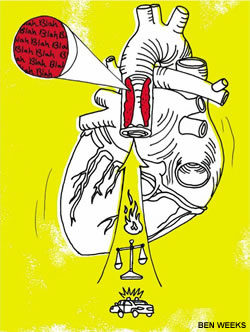Heart Attack
Despite many evolutionary changes, beat reporting remains the lifeblood of newspapers.So why is the Globe clogging its arteries with marquee columnists, a glut of Ottawa coverage and so much “news you can use”?
On a late fall morning, Kirk Makin walks out of room No. 13 in Ottawa’s Elgin Street courthouse. His tall, imposing figure stands above a clutch of lawyers and court officials. The hearing he’s covering — Her Majesty the Queen vs. Ontario Power Generation, John Tammadge and Robert Bednarek — has just finished, and Makin’s journalistic guard is temporarily down. Attorneys call him by his first name, talking to him as if he is a colleague rather than a reporter. OPG’s lawyer, Donald Bayne, speaks to him in the hushed tones of a co-conspirator. More lawyers gather around, and soon Makin and Bayne are part of a group of 10. They talk and joke about the case in the relaxed, off-the-record manner of old associates. The lawyers try to persuade Makin to come to dinner with them that evening, as he sometimes does, but this time he declines. “We’ll have your glass then,” says one of them. Makin, who has worked at The Globe and Mail for over 20 years, is considered the gold standard in beat reporting by colleagues like Ian Brown and Marina Jiménez. “If it wasn’t for Kirk,” says Paul Taylor, a Globe staffer since 1979, “there would be some innocent people sitting in jail.” People like Guy Paul Morin. Makin covered the Morin case over an eight-year period and wrote a best-selling book on the subject, Redrumthe Innocent. Thanks largely to Makin’s endeavours, Morin was exonerated in 1995.
 But Makin, a court reporter who gradually became a justice reporter, also epitomizes the way the beat system has evolved at the Globe. Beats that were once narrowly focused are now concerned with social issues and trends, or as one Globe veteran puts it, “things going on in society that need explaining.” In Makin’s case, that means a beat that’s more about laws and the functioning of the justice system than about the trials and tribulations of lawbreakers. Along the way, life has become more demanding for beat reporters. News holes have shrunk, and competition for available space has intensified. Reporters vie not only with other reporters, but also with the growing ranks of opinion columnists who increasingly dominate coverage. And newspapers such as the Globe no longer exist in isolation as they once did, but form pieces of larger media organizations. This means more work for reporters on more than one media platform. Deadlines have proliferated, but now they’re for quick newsbreaks that will be posted on the paper’s website, for a breezy television commentary on CTV Newsnet, and last but not least, for the paper itself. To stay on top of a beat, reporters have to go to conferences, speak to groups and generally blend in with the people they cover, all the while retaining their independence and distance. Once a job, beat reporting has mutated into a way of life.
But Makin, a court reporter who gradually became a justice reporter, also epitomizes the way the beat system has evolved at the Globe. Beats that were once narrowly focused are now concerned with social issues and trends, or as one Globe veteran puts it, “things going on in society that need explaining.” In Makin’s case, that means a beat that’s more about laws and the functioning of the justice system than about the trials and tribulations of lawbreakers. Along the way, life has become more demanding for beat reporters. News holes have shrunk, and competition for available space has intensified. Reporters vie not only with other reporters, but also with the growing ranks of opinion columnists who increasingly dominate coverage. And newspapers such as the Globe no longer exist in isolation as they once did, but form pieces of larger media organizations. This means more work for reporters on more than one media platform. Deadlines have proliferated, but now they’re for quick newsbreaks that will be posted on the paper’s website, for a breezy television commentary on CTV Newsnet, and last but not least, for the paper itself. To stay on top of a beat, reporters have to go to conferences, speak to groups and generally blend in with the people they cover, all the while retaining their independence and distance. Once a job, beat reporting has mutated into a way of life.
“It seems like societal values have changed, and the beats are reflecting that,” says Globe education reporter Caroline Alphonso. “Years ago people weren’t interested in social trends, but now we’re writing about people giving their dogs massages — and it’s going on the front page. It’s a ‘news you can use’ kind of thing.” Alphonso and former education reporter Jennifer Lewington represent the past and present of education reporting at the Globe. Lewington, who is now Toronto City Hall bureau chief, says many education issues haven’t changed, but the way the paper presents them has. “Instead of me writing about charter schools,” she says, “Caroline’s writing about parents living on campus to get a taste of university life.”
For many at the Globe, the tipping point for the beat system came in 1989, the year A. Roy Megarry became publisher and William Thorsell editor-in-chief. Thorsell wasted little time exploding the accepted notion of beat reporting. “He just declared there was going to be a national education beat, and people looked at him like, ‘How could you have a national education beat, it’s a provincial entity?’” Lewington recalls. But Thorsell was firm and she came around. “That allowed the Globe, unlike anybody else, to look through the prism of what was happening in Ontario versus what was happening in British Columbia.”
Tim Pritchard, the Globe’s managing editor at the time, says Thorsell’s idea to change the beat system was a good one. Thorsell himself says that he was “always optimistic about the future of newspapers.” But according to Pritchard, both men knew the realities of their time, and accepted that newspaper readership was diminishing. They could see the newspaper business losing its “news edge,” and the need for beat reporters to be able to string together news patterns to provide information that readers couldn’t get anywhere else. So Thorsell developed a “double agenda” strategy: deinstitutionalize the classic beats, and then go and find out “what’s actually happening” and what matters to Globe readers. According to Thorsell, one of the most successful new beats was “development issues.” For the first time, the Globe had a foreign beat, with its Delhi-based reporter John Stackhouse roaming throughout India, Africa and Southeast Asia for stories. “I certainly wanted to have a heartbeat of strong beat coverage,” says Thorsell. “Frequently, the daily news agenda does not justify the reader’s time.” Thorsell saw the Globe as a magazine that should produce more trend stories, so he broadened the mandate of the beats. “We revamped some old beats, we added some new ones and for the most part it went pretty well,” says Pritchard. The system — which included new beats such as “social trends” and “ethics and religion” — worked for a while, but Thorsell’s managing style didn’t endear him to some staff. “Thorsell is what I call a top-down manager.
He really thought he was on top of everything and he knew what should be going in the paper, and wasn’t as dependent on the knowledge and the skill of his beat reporters as I was,” says Pritchard. Many in the newsroom were not pleased. “A reporter who was in the arts section came by my office and said, ‘I just spent 40 minutes talking to the editor-in-chief and during that 40 minutes he told me everything he thought I should be doing and didn’t ask me one question about what I was working on or what I thought about anything,’” recalls Pritchard. “Thorsell and the other senior editors increasingly began to feel that they knew what was going on and they would tell the reporters what was going on. Once you start undermining the beat system like that, beat reporters feel undervalued.” To compound matters, Thorsell introduced “Super G.A.’s” — star general assignment reporters who were sometimes given priority over beat reporters on breaking news.
Over time, though, the new approach took hold. Joan Hollobon, who mined the medical beat for 25 years primarily by attending medical meetings, now watches the Globe’s exploding health coverage from retirement. “I look at the paper and there’s Andre Picard, there’s Carolyn Abraham and a whole lot of other people doing either medicine or peripheral health issues around medicine,” she says. Hollobon did it with legwork, but today medical writer Paul Taylor is inundated with story ideas without leaving his desk. He sifts through hundreds of emails a day, and looks at several hundred medical or scientific studies per week. “What it’s actually done,” he says, “is greatly increase the workload.”
Wilf List, Hollobon’s contemporary, covered labour for 35 years — the longest time any reporter at the Globe has ever worked on a single beat. His successor, Lorne Slotnick, would have no such longevity in what became the “workplace beat.” Pritchard says Slotnick had a very narrow vision of the labour beat. He wanted to write about unions and bargaining situations. Thorsell disagreed with his labour reporter, and broadened the beat to include all aspects of the workplace, including issues like technology, downsizing and staggered hours. Slotnick eventually quit.
His fate was part of the larger political dynamic at the paper. According to Makin, Globe reporters believed the orders for change were coming directly from the publisher. Megarry’s contacts in the business community “did not see us as friendly to them,” Makin says. “They thought there were too many left-wing zealots writing for the paper.” As Pritchard recalls, Megarry had a saying that summed up his perceived need for management intervention, particularly in the news section: “The newsroom is an asylum that’s being run by the inmates.”
Makin, for one, escaped the worst effects. In the early 1990s, by agreement with his editors, he shifted his attention from prisons to the Supreme Court of Canada, and the “legal” beat became “justice.” According to Makin, the Supreme Court was becoming much more important. “I recognized that, and my editors also recognized that,” he says. Plus, it was clear to Makin that his editors were losing interest in his prison stories, and when that happens, he says, “You either move with the tides or you may be looking at a different line of work.”
To Colin MacKenzie, now managing editor of the Globe’s news side, the evolution has been natural. “As with society, beats evolved,” he says. “We cover health obsessively, as you can see from the paper, but that’s changing with the culture.” Labour, on the other hand, no longer had a “central place in the national conversation,” so the beat had to change. As for social trends, MacKenzie justifies the beat by saying that “newspapers are much more ambitious in how they try to analyze all parts of life.”
But the Globe is still a beat-driven paper “if you include Ottawa among the beats, which you should,” says Catherine Wallace, a former Globe editor who is now an assistant managing editor at The Gazette in Montreal. “It’s a paper that likes to have exclusives, and it leaves people on the same beat for enough time to develop stories.” As Wallace and others note, though, the news hole in some editions (such as the national edition) is tight and competition for available space has become tougher, thanks in part to the growing influence of columnists. “There have always been star columnists who are so popular with readers that when they write something it gets in,” says Wallace. “What’s different now is that the columnists are being used for news coverage as well.”
“Look at the Globe today and the Globe 10 years ago,” says Lewington. “The amount of column inches devoted to opinion versus storytelling — that’s where the trend has been.” Alphonso agrees. “There is a fight there,” she says. “A lot of opinions make their way into the paper, and beat reporters are fighting for news stories to get in.”
This struggle didn’t become any easier with the arrival of the National Post in 1998. For about the first year, “at the Post we didn’t have a system of beat reporting,” says Marina Jiménez, who was a reporter there prior to joining the Globe. She says that before reporters fell into their areas of interest, “it was a free-for-all, and we were thrown on the big story of the day.” The Post also pushed columnists to the forefront as news writers with opinions. The Globe’s competitive response, in part, was to dismantle or diminish many beats. “For reasons that none of us could fathom, they just dropped or changed a lot of beats,” says Lewington. There was even a short time, she adds, when the Globe had very light coverage on the education beat. Alphonso rectified that problem in 2003, when she stepped in.
The paper’s editorial predilections after the Post arrived also played a role in reshaping the beat system. Under editor-in-chief Edward Greenspon, coverage of Ottawa has become even more prominent. “Ten years ago we didn’t have three people writing columns from Ottawa, for God’s sake,” says Lewington. Wallace and Alphonso concur, with Alphonso taking the criticism one step further. “There is a formula to the front page. There are always two Ottawa stories, a foreign story and — maybe — one beat story.” But MacKenzie doesn’t believe columnists crowd out beat reporters. “I guess we’ve got one more Ottawa columnist then we did have, but there always was a city columnist, a Queen’s Park columnist.” He says the amount of analysis is the same, yet the way stories are reported is different. “The Post changed a number of things,” he says, “principally news reflex, which impacted beats as well.”
With heightened competition from the Post, feature writing took a hit. “You’re specifically looking for breaking news stories,” says MacKenzie. But the Globe, he adds, has the beats to thank for the bulk of its exclusives and Saturday specials. “It’s as much a beat-driven paper as it ever was,” he says. “In order to have a boogie, you’ve got to have a bottom, and that’s your beat system.”
Nowhere is it more evident than in the Globe’s Report on Business section. Currently, ROB’s beats include economics, retailing, media, mining, global energy, technology, the auto industry, telecom, transportation, real estate, investment, biotechnology, mutual funds, the workplace, steel, marketing and banking. By one estimate, 90 per cent of the reporters on ROB have beats. “All business sections are beat-driven because they have to be,” says Paul Waldie, a business specialist at the paper who nevertheless has no specific beat himself. “You need someone to follow banks all the time, to follow transportation all the time.”
Waldie says he prefers being a generalist, arguing that he learns more that way. Still, he’s been sucked into news cyclones that are hard to escape, in essence becoming a story specialist instead of a beat reporter. He has become the Globe’s ranking Conrad Black expert over the past three years, and, prior to Black’s criminal trial, was anxious for it to start. He has already flown to Chicago to cover the events leading up to the trial. This kind of expertise is now exploited in much more than the paper’s news columns. “There are days, literally, where I’ll write a story for the web in the morning, a story for the paper in the afternoon and go on ROB TV that night,” says Waldie. “You’re doing all three things at once, and it’s not just me.” He spends so much time in this news media triangle he rarely has time to step outside the office.
Television, in particular, changed the way beat reporters function, says Makin. It takes time to tape TV spots, and because reporters have to be in the office to do them, their mobility is reduced. Then there’s the worry of having to fully understand their story for a noon taping instead of the usual 6 p.m. copy deadline.
There is also the fear of becoming obsolete. Waldie, for one, thinks newspapers eventually must succumb to the Internet. Business news in newspapers — now consumed mostly by middle-aged or older men, as opposed to twenty-somethings — is losing ground to the Internet. And according to Waldie, the web is not beat-friendly. “The people that we’re hiring tend to be the web people, and those people will be generalists,” he says. “Maybe at some point the web will evolve to having beats, but I doubt it.”
Web or no web, there’s lingering dissatisfaction with the Globe’s modified beat system. Former ROB reporter Kimberley Noble says the Globe, “is not a confident newsroom in the way that it was,” blaming the change on the micromanagement of beat reporters’ story ideas by their editors.
Even in an ideal newsroom situation, beat reporting is far from perfect. Former Globe writer — now Toronto Star business and public affairs writer — David Olive points to the danger of beat reporting as a general practice. “You end up becoming one of them,” he says, citing fashion, business and sports reporters as examples. “You are somewhat beholden to the beat you’re covering.”
In the case of fashion in particular, Olive may have a point. But as far as most other beats go, Makin disagrees. “At a serious paper that’s trying to do a serious job, I don’t think someone who is a cheerleader is going to be tolerated for long.” Maintaining distance and perspective from sources, he says, is “part and parcel” of the job.
As is making public appearances. Makin stands at the front of a computer lab at Toronto’s Centennial College, talking to a small class of journalism students. Four women sit attentively in the front row, three guys at the back videotape his presentation, and journalism program co-ordinator Lindy Oughtred watches and takes notes.
Unlike Waldie, Makin has no trouble getting out of the office. Though he turns down many requests because of time constraints, he visits colleges and universities about once a month. A few days earlier, Makin spoke to 80 captivated University of Toronto law students after a screening of a 1992 episode of the fifth estate on the Morin trial. Makin was chief consultant on the program, and appeared on camera, sporting what he calls his “porn director’s moustache.” Now moustache free, Makin considers speaking engagements part of a beat’s maintenance. “There’s only a certain period where there’s fruit in the trees,” he says, “but you have to do a whole lot of gardening in between.”
Makin tilled the soil at U of T last year as well. He won a Canadian Journalism Fellowship at Massey College for 2005-2006, and studied law courses such as constitutional litigation. He hasn’t freed any innocent men in the past decade — though he still sees Morin regularly — but perhaps one is enough for a beat reporter’s career. He continues to spend time talking to lawyers and judges at numerous conferences, and still reads legal publications late into the evening. “That’s what a beat is — a lifestyle,” Makin says. “There’s a lot of stuff my employers really don’t know I do.”
Julia LeConte was the Production Editor for the Spring 2007 issue of the Ryerson Review of Journalism.













































